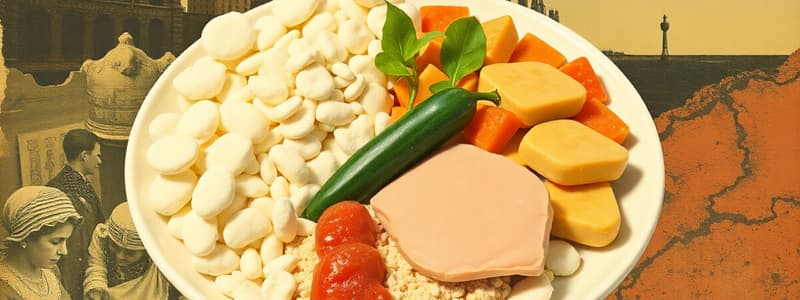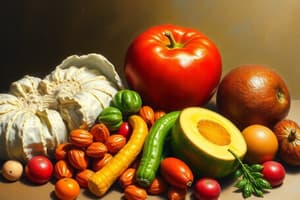Podcast
Questions and Answers
What are the seven food substances you must eat to stay healthy?
What are the seven food substances you must eat to stay healthy?
Carbohydrates, Lipids (fats), Proteins, Vitamins, Minerals, Fiber, Water
Which three nutrients are classified as macronutrients?
Which three nutrients are classified as macronutrients?
Carbohydrates, Lipids, Proteins
What are the basic units that make up carbohydrates?
What are the basic units that make up carbohydrates?
Simple sugars
From what are proteins made?
From what are proteins made?
What are the two categories of carbohydrates?
What are the two categories of carbohydrates?
What is the stored form of sugar in animals called?
What is the stored form of sugar in animals called?
What elements make up lipids?
What elements make up lipids?
Lipids from plants are usually solid at room temperature.
Lipids from plants are usually solid at room temperature.
What are the building blocks of lipids?
What are the building blocks of lipids?
What percentage of the human body's mass is made up of proteins?
What percentage of the human body's mass is made up of proteins?
Flashcards are hidden until you start studying
Study Notes
Balanced Diet
- A balanced diet consists of seven food substances: carbohydrates, lipids, proteins, vitamins, minerals, fiber, and water.
- Out of these, carbohydrates, lipids, and proteins are considered macronutrients, providing the majority of calories for the body.
Carbohydrates
- Carbohydrates make up a small percentage of human body mass, only 1%.
- They are the primary source of fuel for the body, providing energy by oxidizing glucose, a process known as cellular respiration.
- Carbohydrates are categorized into two main types: simple carbohydrates and complex carbohydrates.
Simple Carbohydrates
- These are broken down quickly by the body for energy.
- They are commonly referred to as “sugars”.
- Simple carbohydrates are further divided into:
- Monosaccharides: single sugar molecules, such as glucose, fructose, and galactose.
- Disaccharides: two sugar molecules combined, such as sucrose, lactose, and maltose.
- All carbohydrates are composed of three elements: carbon (C), hydrogen (H), and oxygen (O).
Complex Carbohydrates
- Complex carbohydrates are made up of long, complex chains of sugar molecules.
- They are polymers, large molecules formed by repeating units called monomers.
- Examples include starch and glycogen.
- Starch is a large, insoluble molecule stored in plants, found in foods like rice, potatoes, and wheat.
- Glycogen is the stored form of sugar in animals, found in the liver and muscles, where it can be quickly converted to glucose for energy.
Lipids
- Lipids, or fats, constitute about 10% of the body's mass.
- Lipids are made up of the same three elements as carbohydrates: carbon, oxygen, and hydrogen, but in different proportions.
- They have various functions:
- Essential structural components of cells.
- Insulation under the skin to prevent heat loss.
- Long-term energy storage.
- Protection of vital organs from mechanical damage.
- Lipids can be solid or liquid at room temperature. Animal fats are typically solid, while plant oils are usually liquid.
- The building blocks of lipids are glycerol and fatty acids. A molecule of glycerol combines with three fatty acids to form a lipid.
- Saturated fats, common in animal fats, have no double bonds in their chemical structure.
- Unsaturated fats, more common in plant oils, have double bonds in their chemical structure.
Proteins
- Proteins make up about 18% of the body's mass, second only to water (55-60%).
- All cells contain proteins, which are crucial for:
- Growth and repair.
- Building and repairing tissues.
- Producing enzymes, hormones, and antibodies.
- Transporting substances within the body.
- Providing structural support.
- Proteins are composed of amino acids, which are linked together by peptide bonds to form long chains.
Studying That Suits You
Use AI to generate personalized quizzes and flashcards to suit your learning preferences.




